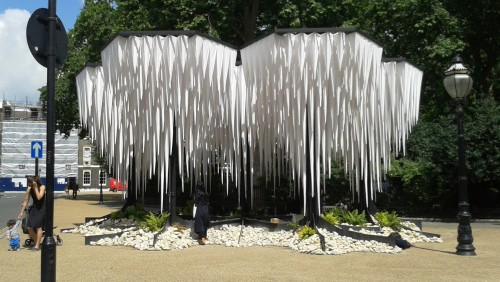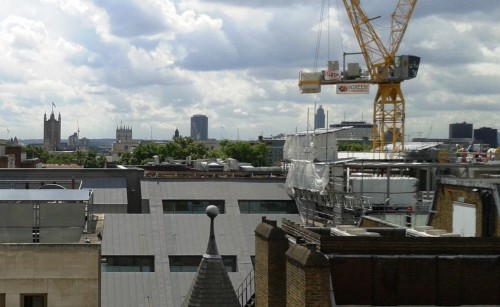9th July 2014
A Day in Londongrad
Every so often Belarusians comment to me that London attracts Russians. The British media regularly report on their activities. The Guardian newspaper recently stated that there are 150,000 Russians living in “Moscow-on-Thames”. And two of our newspapers – the Independent and the London Evening Standard are owned by a Russian.
I spent a day in London last week at meetings on Belarus. As they were in different parts of London, I had time to think about the subject as I made my way by over ground and underground across the city.
I did pass Russian speakers – a group of students on their way to the British museum and a family on the tube. But I heard more of other languages – especially Spanish and German. I met a German woman who was working on this installation in a London square – designed by a Chilean.
There were a few signs in Cyrillic around the city. The most obvious foreign community seemed to be Brazilians – whose flags were everywhere and whose football shirts are this year’s fashion (so much for the craze for Union Jacks because of the 2012 Olympics…)
In my local supermarket, the space for Polish products keeps increasing, although much more space is reserved for ingredients and ready meals of South Asian dishes. But that’s because we Britons have taken to curries and other South Asian dishes “big time”.
A horizontal city, with a vertical centre
Travelling across London with fresh eyes made me realise how horizontal a city London remains. The city is still a very random mix of long lines of terraced housing in the inner suburbs, more detached housing in the outer suburbs. And with lots of small centres – the London “villages” – with green spaces dotted around everywhere.
The centre of the city, however, is now going vertical. The high cost of property in London frustrates ordinary Britons and worries policy makers, as the cost of living in London keeps rising relative to the rest of Britain. A more vertical city is one way to meet the rising demand for housing.
Compared to Minsk, there are still relatively few high rise residential housing blocks. Most of the vertical buildings being built are offices, especially focussed on the City of London. But, if the numbers of people who arrive in London looking for work keeps rising, that may change.
Under construction
London isn’t just a building site for new high rise buildings. There are major infrastructure projects also underway. Last time I visited in May, I transited Victoria Station. I hadn’t realised that the area around the station is undergoing major reconstruction – my taxi was stuck for ten minutes trying to get out of the station.
This time I came across the works at Tottenham Court Road tube station, at one end of Oxford Street. The station will be on a new underground railway – Crossrail. This will be a longer and faster line to allow passengers to travel quickly across London. I suppose this is another response to the high cost of property, but its aim is to link the western suburbs and satellite towns with the east of the city where the financial district is moving to.
As the Crossrail website states, rather poetically I think, the routes will “… weave their way between existing underground lines, sewers, utility tunnels and building foundations from station to station”. Much of London’s infrastructure, especially the underground, was built over a hundred years ago, and the heights and capacities of trains were designed for that era. Major works in London are complicated and cost proportionately more.
More Londonheim or Warsaw-on-Thames
On my return to Minsk, I researched the subject of Russians in Britain. My impressions of London weren’t so far off. According to figures produced by the Office of National Statistics and based on the 2011 census, Russians are actually the 36th largest community of foreign residents in the UK at 36,000.
The largest communities are those of Commonwealth countries (countries of the former British empire), or EU member states whose citizens have the right to reside in the UK. So the largest communities are Poles (700,000), Indians (348,000) and Irish (314,000). Thereafter, its Pakistanis and Germans, followed by communities from other EU nations.
Of course, official statistics don’t capture the transient nature of the richest residents, and the size of the resident population is only one measure. Property purchases and other capital investments by Russians in Britain have been significant in the last decade or so. But it only takes a few people of high profile – owners of Premier Football League Clubs or newspapers – to attract attention.
So I conclude that the idea of Londongrad is something of a cliché that journalists (and FCO bloggers) use to attract readers.
The reality is more complex. London has many foreign communities, but there is no one dominant group. That is the joy of London – and perhaps the despair for the rest of England – that the city is so varied and cosmopolitan. There is a stronger case for calling it Londonheim (or perhaps Londonburg?), Londonistan (as an eminent former colleague described it some years ago) or Warsaw-on-Thames (especially in the western areas of Hammersmith and Ealing).
During my criss-crossings of London, I walked across Trafalgar Square right at the heart of London. Apart from a tall column devoted to Admiral Nelson, the victor of the sea battle of Trafalgar against Napoleon’s fleet in 1805, the square has four large plinths. Three of them are occupied by statues of two eminent generals and a former king.
The Fourth Plinth in the north-west corner of the square was left bare. Since 1999, it has been occupied by a piece of contemporary art. It is currently occupied by this huge blue cockerel.
This is an emblem of France – an interesting piece of juxtaposition in a square devoted to a victory over the French. And the sculptor? Katharina Fritsch, a leading German contemporary artist. That tells you more about London now, than any number of words from me or anyone else.
Related articles




It’s rather interesting how certain parts of London house various nationals. I find SouthKensington to be generally populated by French nationals and Knightsbridge by Russians and people from the Middle East.
Thanks for this article Bruce, well written.
http://www.express-installers.co.uk
Dear Bruce ,
well , Brazil ´s football shirts are surely quite fashionable this year – but the ” Union Jack´s ” ones might be trendy e t t r é s c h i q even in 100 years. But seriously : it was interesting to read ´bout the differences between London & Minsk in re . of these ” high rise residential housing blocks”. But you ´re right : it may change ( surely…).
Most notable to me was yr. list ´bout all these (sometimes very different ) communities – living their peaceful lifes in the UK ´s capital. A fact which is also for me everytime again fascinating & exciting. Esp. all their cultures and religions. So thank ´s a lot for this “communities…”-link. To conclude : most important to me is yr. “K-Line” , that there ´s really no “dominant” group amongst all those millions of people. Pls : if London is perhaps a ” despair” for the “rest” of England – well this rest has the full right and the pleasure to follow and build up their area in the same way. So don ´t hesitate…England !
” A man who is tired of London is tired of life itself ” ( G.B. Shaw)
Best wishes & enjoy this Wednesday , liebste Grüßle & geniess Deinen
Mittwoch,
Ingo-Steven, Stuttgart